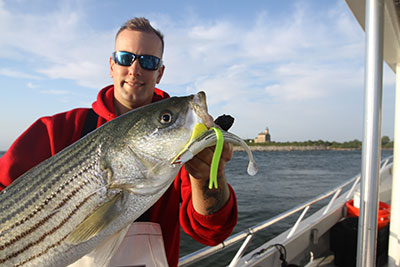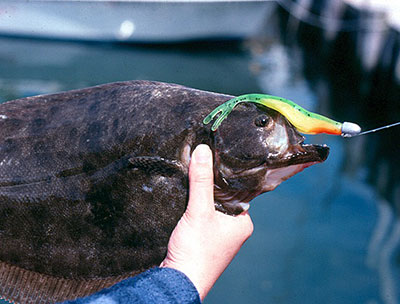
By Tom Schlichter
Saltwater anglers today have grown comfortable with tossing soft-plastic swim baits and grubs for just about any predatory species that swims in our waters. From stripers and weakfish to fluke and even scup, there’s almost no fish that can’t be caught on some soft, pliable, life-like imitation designed to match bunker, bay anchovies, sand eels, spearing and the like.
Once the vanguard of freshwater bass and walleye pursuit, today’s soft plastic line-up now includes dozens of lures perfect for matching the hatch in saltwater environs. Refined over the years to offer a facsimile of just about every baitfish species that swims they can be switched for another profile, size, color or action in a matter of seconds. In many cases you might not even need to retie your rig because you can slide one soft body off the hook and replace it with another.

A small tidal creek I like to work for school stripers and an occasional keeper illustrates this point clearly. The water here passes under a culvert. As the current pinches and picks up speed, schoolies take up position in a small drop-off just down-tide from a sand bar. I work this pocket consistently using a variety of soft plastics, starting with small, lightweight, straight-tailed offerings in late April when the fish are sluggish, and progressing to larger designs with curly tails and paddle tails through early June. I’ll throw white most of the time in the clean, crisp waters of early spring, a natural bunker or mullet pattern as zooplankton begins to color the water, and a chartreuse pattern if rain and wind cloud up the creek.
The point is, soft plastics make it easy to match the size and appearance of growing or changing baitfish species, temperament of target fish and even the clarity of the water. As a rule, I fish most of my soft bodied lures without teasers and directly behind a jig head ranging in size from 3/8- to 2 ounces. If I want an additional splash of color, more exaggerated action or a larger profile without more weight, I add a Fat Cow trailer. Should I need a soft plastic lure to fall more slowly, I’ll add it to a deer hair bucktail instead of a bare jighead. With the smallest soft plastics, I’ll use spinning gear and 8- to 20-pound test braid or 12- to 15-pound test mono line. Obviously, with larger plastics targeting bigger fish, you’ll need to go to heavier gear.

SNAP TO IT
The invasion of tiny snappers on the inshore scene in early July presents another opportunity to match the hatch with soft plastic lures. By the time the diminutive blues first begin to grab onto your offerings, you can bet that fluke, weakfish, blues and even a few striped bass have begun to consider them a primary food source.
With that thought in mind, small silver, pearl and blue curly tail bodies come into play. As the little blues become more and more aggressive and increase in size, bump up to a four-inch paddle tail to more closely resemble a snapper profile and body shape. Similar selections can double as peanut bunker patterns when that mass exodus gets under way in late August and early September.
GO BIG THIS FALL

During spring and early summer, it often helps to drop down a size or two when the bite takes a breather. In the fall, the opposite tends to be true. With bigger bait getting ready to head south, larger fish in hot pursuit, and evening temperatures chilling the water just enough to bring a little urgency to the feeding patterns of local gamesters, moving up to larger soft plastics often results in more action and bigger fish. Larger Slug-Gos and Fin-S-Fish in the six- to nine-inch class can imitate large sand eels, big spearing and live eels while Tsunami Wild Eye Shads and Panther Martin BigFin paddle-tail swimbaits in one- and two-ounce sizes match well with adult bunker, sand eels, snappers and even mullet.
As you can see, soft plastics fit the bill for a wide variety of fishing conditions throughout the year. Additional match-ups that have served me well in recent years include Fin-S-Fish, Bass Assassins and Kalin’s Evil Eels for bay weakfish, school stripers and bluefish feeding on evening tides around bridges, bulkheads and shadow lines. The larger Slug-Go sizes ranging from six- to 12 inches in pink match live squid while dark purple or black in a nine-inch size can be used to imitate eels when twitched slowly around structure, especially after dark.
The point is there are virtually endless possibilities with today’s soft plastic battery. Figure out a few you like and stock up, making sure to cut in new styles and sizes from time to time. The soft plastic revolution continues to reshape fishing possibilities. For greater success, embrace its on-going evolution and make these lures a staple in your everyday arsenal.









